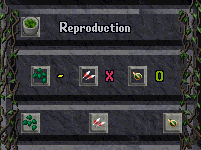When a plant first reaches its full-grown state, it will sprout its full foliage, no longer contained within the plant bowl. At this stage of the plant’s growth, it will begin to produce pollen. You can view your plant’s current Pollination State in the Plant Resources Menu.
The plant will eventually self-pollinate if left unattended, and then begin to produce seeds. Seeds produced by a self-pollinated plant will grow up into an exact duplicate of the “parent” plant.
Once a plant reaches the pollen-producing stage at days 7 – 9 of the cycle, its pollen may be gathered by the owner by using the Cross-Pollination button. Gathered pollen may be used on another full-grown plant. When you pollinate one plant with pollen from another plant, the targeted plant will produce seeds that will grow into a hybrid of the two plants.
Plants were initially added to the game in four generations. A bug introduced in 2009 accidentally replaced one of the first generation plants, tribarrel cactus, with a random seed. The consequences of this are explored in the page Colored Peculiar Plants. For historical reference the original four generations were as follows:
First Generation
- Tribarrel Cactus
- Fern
- Campion Flowers
Second Generation
- Water Plant (tribarrel x fern)
- Lillies (campion x fern)
Third Generation
- Snowdrops (lillies x campion)
- Rushes (lillies x fern)
- Small Palm (water plant x fern)
- Prickly Pear Cactus (tribarrel x water plant)
Fourth Generation
- Barrel Cactus (tribarrel x prickly pear)
- Snake Plant (water plant x prickly pear)
- Century Plant (water plant x small palm)
- Ponytail Palm (small palm x fern)
- Elephant Ears (fern x rushes)
- Pampas Grass (rushex x lillies)
- Bulrushes (lillies x snowdrops)
- Poppies (snowdrops x campion)
Calculating Pollination Results
Pollination State
The Pollination State indicator ![]() displays the current pollination state of a plant.
displays the current pollination state of a plant.![]() indicates that the plant has not yet produced any pollen, as it has not reached full-grown level.
indicates that the plant has not yet produced any pollen, as it has not reached full-grown level.![]() indicates that the plant has entered its pollen producing state, and can have pollen gathered from it, or be cross-pollinated to.
indicates that the plant has entered its pollen producing state, and can have pollen gathered from it, or be cross-pollinated to.![]() indicates that the plant has been pollinated (either by itself, through natural self-pollination, or by the pollen of another plant). While you can still gather pollen from a plant in this state, the plant can no longer be the target of cross-pollination.
indicates that the plant has been pollinated (either by itself, through natural self-pollination, or by the pollen of another plant). While you can still gather pollen from a plant in this state, the plant can no longer be the target of cross-pollination.
Crossing Plant Colors |
|||||||
| Red | Blue | Yellow | Purple | Green | Orange | Plain | |
| Red | Bright Red | Purple | Orange | Red | Red | Red | Plain |
| Blue | Purple | Bright Blue | Green | Blue | Blue | Blue | Plain |
| Yellow | Orange | Green | Bright Yellow |
Yellow
|
Yellow | Yellow | Plain |
| Purple | Red | Blue | Yellow | Bright Purple | Blue | Red | Plain |
| Green | Red | Blue | Yellow | Blue | Bright Green |
Yellow
|
Plain |
| Orange | Red | Blue | Yellow | Red | Yellow | Bright Orange | Plain |
| Plain | Plain | Plain | Plain | Plain | Plain | Plain | Plain |
Brightness:
– Plain, black and white seeds are all dull colored. ![]()
– All other colors come in dull and bright versions.
– Brightness of the child is determined by the color of the parents.
– Brightness of the parents does not influence brightness of the child.
– Crossing two different colors yields a dull color.
– Crossing two identical colors yields a bright color.
– Self-pollination will result in the same color and brightness.
Regular Colors:
– All colors except plain, black and white come in dull and bright versions.
– There are three primary colors: red, blue, yellow. ![]()
– There are three secondary colors: purple, green, orange. ![]()
– Crossing two identical colors will give that color.
– Crossing two different primary colors will give a secondary color.
– Crossing a primary and a secondary color will give a primary color.
– Crossing two different secondary colors will give a primary color.
– Crossing plain pollen with any other pollen will give plain pollen.
– Black and white seeds are random mutations. Plants of this color give no seeds.
Special Colors and Bonsai Trees:
– Four rare colors have been introduced with the “Naturalist Quest”.
– The rare colors are pink, magenta, aqua and fire red. ![]()
– Five different Bonsai Seeds have been introduced with the Samurai Empire Expansion.
– Both the rare colors and the Bonsai Seeds are considered mutants and give no seeds.



